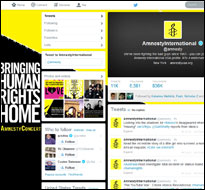
High-profile online campaigns such as Kony2012 and the much-documented role of the Internet in global uprisings have created a buzz around the potential of the Internet as a tool for organizations to catalyze social action. But beneath the headlines there is a lively debate about the impact of the Internet on activism. Advocates such as New York University’s Clay Shirky point toward how the Internet has lowered the traditional barriers to collective action. Others, including Matthew Hindman, reply that while the Internet has lowered transaction costs, production costs remain relatively unchanged; further, while the openness of the Internet makes it easier to speak, in a more competitive environment it remains “difficult to be heard.”
For many NGOs that have struggled to get across their message through mainstream news organizations, the idea of being able to communicate directly with the public is appealing. This is particularly true for international NGOs in areas such as human rights, for whom generating publicity may be considered a core part of their work and who have historically struggled to get traction for their issues in the mainstream news. For these organizations, understanding how the Internet can help them to reach wider audiences is an issue of real significance. Despite this, little quantitative research has been done on this subject.
A 2014 study published in the International Journal of Press/Politics, “May We Have Your Attention Please? Human Rights NGOs and the Problem of Global Communication,” aims to address this research gap. The authors, Trevor Thrall and Diana Sweet of George Mason University and Dominik Stecula of the University of British Columbia, used a quantitative survey of the coverage 257 human rights NGOs achieved in mainstream international news media and through social media to better understand the impact of the Internet on the ability of such organizations to communicate.
The study’s findings include:
- International human rights NGOs struggle to communicate through the global mainstream media. In any given year, 40% of the NGOs included in the study failed to appear in one news story and 25% failed to appear at all between 2010 and 2012.
- Where NGOs do achieve media coverage, it is heavily skewed toward a small number of larger organizations with greater resources. Amnesty International, Human Rights Watch and Oxfam accounted for 50% of all NGO news appearances between 2010 and 2012. Ten percent of the NGOs sampled made up 90% of the coverage.
- Instead of solving this problem for smaller NGOs, the Internet seems to have further polarized the global public’s attention. The top 10% of the sample accounted for 90% of YouTube views, 81% of Facebook likes and 92% of Twitter followers.
- There is a relationship between the ability to generate attention from both traditional news outlets and social media and an organization’s budget. Results indicate there is a threshold of around $10 million annually before NGOs begin to get traction.
- NGOs have a limited ability to direct news coverage on the issues they care most about. However, this depends on strategy and context, and can be seen by comparing the topics NGOs tweeted the most about with news coverage of that issue: While NGOs appeared in 0.9% of news stories in the five most heavily covered topics, they appeared in 7.8% of the stories on the five topics commanding the least coverage. The findings indicate NGOs may therefore be somewhat influential when issues are new or underreported.
- The researchers anticipate that the “evolution of the information environment and the continuing fragmentation of the mass audience will make things more difficult for all NGOs over time.”
The authors explain these results through the “zero-sum nature of public attention.” The Internet simply trades one attention-getting competition in the mainstream news media for another — a competition directly for the public through social media. To win this competition, NGOs need to have the resources necessary to create content that is compelling for the media and the public, favoring a few organizations with significant resources. Previous analysis by Internet optimists overstated the impact of technology on NGO communication by focusing on a few high-profile successes instead of the far-greater number of failures, the researchers suggest. Future research should focus not on the nature of technology, but how technology is likely to affect the distribution of attention over time, how different NGO issue spaces evolve and how NGO strategies and resources can affect this.
Related research: A 2014 study in the International Journal of Communication, “The Structural Organization of NGO Publicity Work: Explaining Divergent Publicity Strategies at Humanitarian and Human Rights Organizations,” by Matthew Powers, provides an alternative argument for the differing coverage NGOs achieve in the mainstream news media. Powers argues that NGO communications strategies cannot simply be understood by “a desire to put issues and locales on the public agenda,” but instead the structure of the NGO, its funding, relationship to the state and desired impact shape its communications strategy.
Keywords: news, social media, Twitter, Facebook, YouTube, human rights, advocacy
